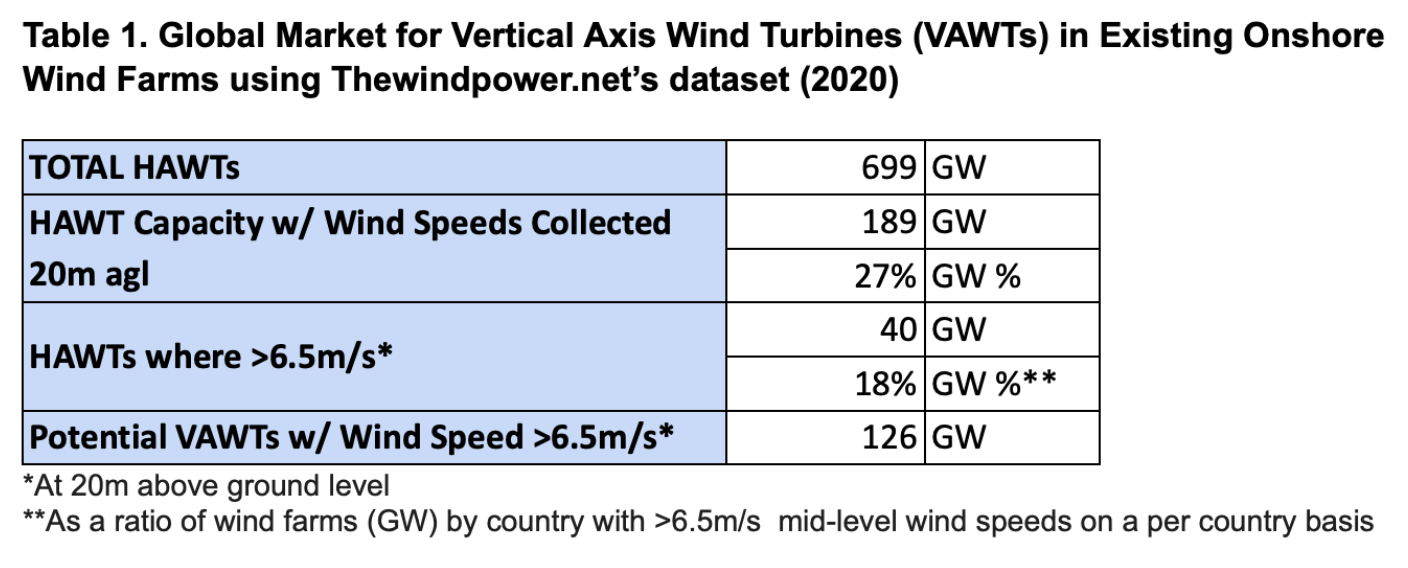Using 2020 data, Wind Harvest analyzed 6944 wind farms from thewindpower.net’s database of 33,108 wind farms using UL Windnavigator’s predicted wind speeds. The analysis shows that 18% of existing onshore capacity have average annual wind speeds >6.5 m/s at 15 or 20 meters (50′ or 65’) above the ground.
In most regions of the world, wind projects in that wind speed can be profitable, especially if the developers can reuse the land and infrastructure as is possible with vertical axis wind turbines installed beneath the canopy of taller turbines.
According to International Renewable Energy Agency (IRENA), onshore wind farm capacity was 699 GW in 2020 (124 GW more than reported by thewindpower.net). It is reasonable to assume the 18% found in thewindpower.net’s database can be extrapolated to IRENA’s number. 18% of 700 MWs would result in 126 MWs of understory VAWT capacity in good to excellent wind speeds in the wind farms that were in operation in 2020.
Note that this assumes on average that VAWTs only double the capacity of the wind farms. In California, a more detailed analysis shows that in addition to the 6000 MWs of HAWTs, the state’s Wind Resource Areas could add 15,000 MWs of VAWTs.
According to IRENA, wind farm capacity increased by an average of 10.5% per year for the past three years. Statista predicts it should increase by 8.3% per year from now until 2030. At these rates, the market for understories of VAWTs would reach 244 GWs by 2030 and 408 GWs by 2034.


In large wind farm projects, VAWTs like Wind Harvesters™ are expected to sell for around $2.5 million per MW. Estimated to be 184 GWs by the end of 2024, the understory wind farm market today is worth over $400 billion and, at the 8.3 growth rate, would surpass a trillion dollars in 2034.
There are two main factors that create the conditions for excellent mid-level wind speeds in 18% of wind farms, and they are related:
- Wind Shear. Most wind farms have wind shear exponents of 0.2 and higher. Most wind farms with excellent wind speeds nearer the ground have wind shears under 0.12. Since the energy in the wind is the cube of the wind speed, a site with twice as high a wind shear exponent is going to have much lower wind speeds at 15m above the ground than at 60 or 80m above ground level. Low wind shear is caused in part by wind funneling.
- Wind Funneling. Topography that funnels wind (a fluid) into a narrower space causes that fluid to speed up. This is the core of Bernoulli’s Principle. Wind speeds up when it squeezes through mountain passes (e.g. San Gorgonio and Tehachapi Passes), over ridgelines (e.g. Jawbone Canyon), over mesas like those in Texas and New Mexico or coastal bluffs (e.g. Australia). In locations with an inversion layer, there is a top to the funnel which increases the wind speed even more.
The map below shows the gigawatt potential of H-type VAWTs in the top 14 countries with excellent mid-level wind resources. To find details on a country by country basis, visit our Library!


